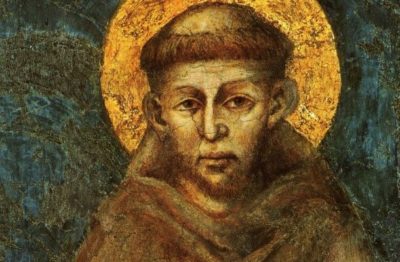 One aspect of Francis’ changing life that has attracted recent attention is the movement of Francis from solitary figure, living a quasi-hermetical life for four to five years, now beginning to live in a growing community of brothers – all of whom are looking to Francis for spiritual and communal leadership. There was something attractive about Francis, his way of following the gospel, and perhaps the recent “commissioning” by Pope Innocent III gave a certain cache of legitimacy to this way of being Christian in the world. Eventually many people came to join the Franciscan movement, which soon enough became a religio and eventually an ordo, but those demarcations are eight to ten years in the future ahead of the Spring of 1209.
One aspect of Francis’ changing life that has attracted recent attention is the movement of Francis from solitary figure, living a quasi-hermetical life for four to five years, now beginning to live in a growing community of brothers – all of whom are looking to Francis for spiritual and communal leadership. There was something attractive about Francis, his way of following the gospel, and perhaps the recent “commissioning” by Pope Innocent III gave a certain cache of legitimacy to this way of being Christian in the world. Eventually many people came to join the Franciscan movement, which soon enough became a religio and eventually an ordo, but those demarcations are eight to ten years in the future ahead of the Spring of 1209.
Virtually all scholars agree that Francis, at this point, did not envision his group to be more than a small group of men living an evangelical life in common. But there are also no indications that Francis thought too far ahead in any matter at this point in his life. Things just seemed to unfold, signs appeared along the way, and Francis followed the path in faith. And people followed Francis. Whether he liked it or not, Francis was their leader.
He also bore one of the signs of leadership – the monk-like haircut called the tonsure – easily recognizable in all the early paintings of Francis and all subsequent graphic portrayals. It is clear from all the sources that Francis received the tonsure from Pope Innocent III, and I suspect the Franciscan world has been arguing for about 750 years about the tonsure’s meaning, Pope Innocent’s intention in giving it, and Francis’ acceptance of this medieval symbol of some kind of ordination or “entering the clerical state.”
Francis had already taken at least one step away from the purely “lay” state. In being embraced by Bishop Guido of Assisi’s cloak in the public scene where he announced that from now on Francis only had God as his Father, Francis became an “ecclesial person” as a penitent subject to the bishop. In medieval times, receiving the tonsure from the church was canonically (i.e., according to church law of that time) to enter the “clerical state,” which meant being ordained and most likely meant to be ordained a deacon. There are many modern scholars who resist this assessment, largely making bald assertions that “clerical” only meant to indicate the ability to read. Yet, the earliest sources (AP and L3C) all record Francis receiving the tonsure and express some bewilderment that Francis’ humility did not prevent the advancement. In other words, these sources seem to acknowledge that Francis accepted some ordination. Why? Perhaps it is no more complicated than Pope Innocent seemed to intuit that followers would come and someone had to be in charge (from his perspective). In the medieval mindset that meant someone had to be ordained to be in charge – hence the tonsure and ordination. Francis, ever the loyal churchman, simply agreed because of obedience. And the topic of “obedience” is the only topic Francis writes about more than the Eucharist.
And the followers began to arrive. And if they expected to find a uniform, posted rules, a great deal of organization, a formation program, or even someone to sit them down and explain what was expected – they were in for a surprise – as was Francis. He found that religious life and living in community cast him in the role of authority and superior – not something he sought nor desired. “Francis assumed that his followers would learn by imitation. Giving them rules or structures to follow was not merely difficult for him; it placed him in a position of superiority that he found painful. He never could formulate his program into rules or present his followers with clear guidance for behavior. This was especially true in this early period, when many of the attitudes he would later adopt had not yet been clarified and solidified.” (Thompson, 40) Francis’ response was to continue to pray, work at the leprosarium near Rivo Torto, go to local churches to participate in Eucharist, eat, pray again, witness to the local Umbrian people near Assisi, and in many ways continue his prior life. Only now it was with an increasing number of brothers. The brothers had to watch Francis closely and do their best to catch the drift.